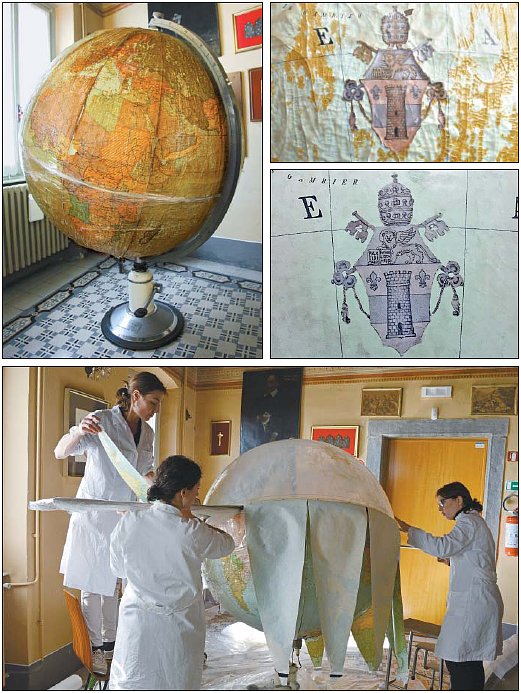Pope John XXIII’s globe gets a new life thanks to hanji : Korean paper has been used in the restoration of Italian cultural artifacts

A globe owned by Pope John XXIII (1881-1963) has recently been restored with traditional Korean paper hanji after a year of conservation work. A museum in Sotto il Monte Giovanni XXIII in Italy, the hometown of Pope John XXIII, plans to display the restored globe to the public soon. [JOHN XXIII FOUNDATION]
They are usually expressing a desire to go outside of their existing boundaries, either physically or mentally, to broaden their perspective.
It’s probably safe to say that such was the case for Pope John XXIII (1881-1963), who reigned as Pope from 1958 until his death.
The globe he owned appears to represent his spiritual conviction.
The globe he acquired in 1960 has recently been restored with Korean mulberry paper, or hanji, the South Korean consulate general in Milan announced.
A museum in Sotto il Monte Giovanni XXIII in Italy, the hometown of Pope John XXIII, plans to display the restored globe to the public soon.
Just how did a historical relic from a faraway country get a new life with Korean traditional paper?
Personal touch
Not long after he was elected pope, Pope John XXIII was looking at an atlas that marked where new churches had been established through propagation activities.
He thought that it would be great if there was a map that identified all the dioceses of the church around the world.
With that, the Vatican tasked a mission in Germany to create a globe. The priests worked together to create a globe measuring 120 centimeters (47 inches) in diameter, 180 centimeters tall, that was modelled after a plexiglass globe kept in a national museum in Vienna.
They installed a light bulb inside so that the globe would light up. They also installed a motor to allow the globe to spin around automatically.
The globe was completed around June 1960.
It’s said that whenever a visitor came to see him, Pope John XXIII would refer to the globe to find out where he or she had come from. He also corrected with his handwriting some locations that needed to be fixed, or added places with dioceses that were not originally marked. They included locations like Chuncheon, Daejeon, Jeonju and Busan, home to Korean dioceses. He also marked places where the pontiff went on pilgrimages.
“Men are like wine - some turn to vinegar, but the best improve with age,” Pope John XXIII once said.
But unfortunately, the globe did not have such luck. Rather, over the past decades its color faded and it became badly damaged.
This is where hanji comes in.

Clockwise from top left: The globe before the conservation; The coat of arms of Pope XXIII before the restoration; The coat of arms after the restoration; Conservationists are seen working on the globe that has been badly damaged over the past 50 years or so. [JOHN XXIII FOUNDATION]
After a year of work, a team of Italian experts has succeeded in restoring the globe at a museum dedicated to Pope John XXIII.
Art conservationist Nella Poggi, who led the group, acknowledged that there were difficulties. He said it was challenging as the more than 50-year-old globe had lost its shape and was slowly deteriorating.
But Poggi reportedly said that the tension of hanji made the work a tad easier. Additionally, hanji is known for its durability and pieces of the paper dating back as many as 1,500 years have been found.
South Korean Consul General in Milan Chang Jae-bok said that he’s happy that Pope John XXIII’s beloved artifact found a new life through hanji.
He said he hopes that “South Korea and Italy will enhance their relations by cooperating through the utilization of cultural assets.”
Since 2014, the Korean government, academia and civic activists have been encouraging Italy to restore its artifacts, such as ancient documents and paintings, using the Korean paper. In Italy and other parts of Europe, Japanese paper has often been the choice for art conservation.
As a testament to its quality, hanji has already been used to restore five of Italy’s important cultural heritage items.
These include the 1224 writing by Saint Francis of Assisi (1182-1226) on a parchment measuring 10 centimeters by 13.5 centimeters.
In December 2016, Italy’s Central Institute for Restoration and Conservation of Archival and Library Heritage (Icpal) issued a certificate approving two types of hanji as appropriate material for restoring and preserving artifacts - both of which are made by master hanji artisan Sin Hyeon-se of Uiryeong County, South Gyeongsang.
BY KIM HYUNG-EUN [hkim@joongang.co.kr]










with the Korea JoongAng Daily
To write comments, please log in to one of the accounts.
Standards Board Policy (0/250자)